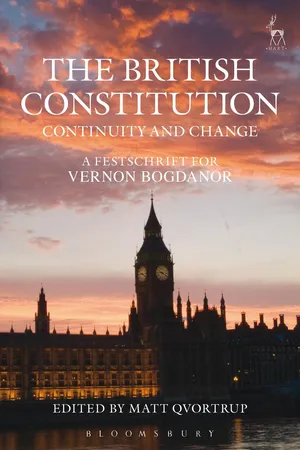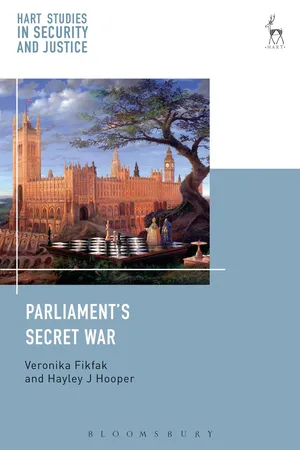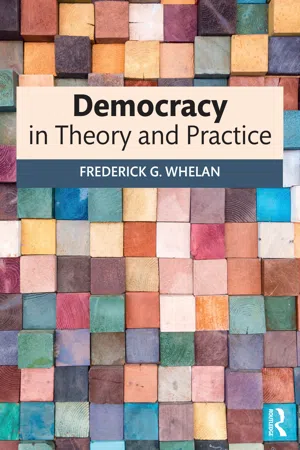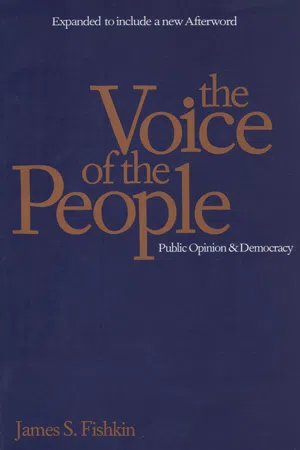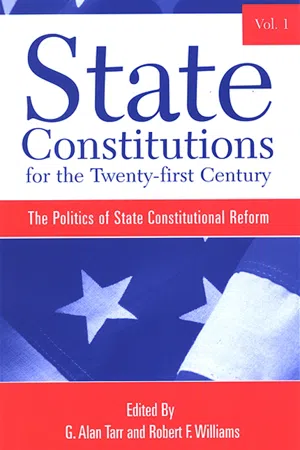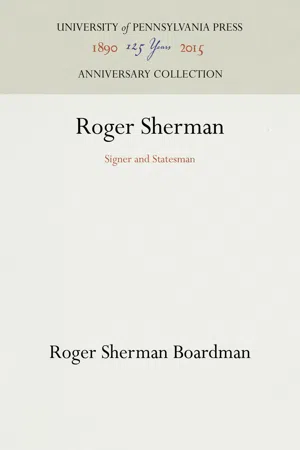History
Constitutional Convention
The Constitutional Convention was a gathering of delegates from the original 13 colonies in Philadelphia in 1787. The purpose was to revise the Articles of Confederation, but instead, the delegates drafted the United States Constitution. The convention resulted in the creation of a new framework for the American government, establishing the principles of federalism, separation of powers, and checks and balances.
Written by Perlego with AI-assistance
Related key terms
1 of 5
8 Key excerpts on "Constitutional Convention"
- eBook - PDF
The British Constitution: Continuity and Change
A Festschrift for Vernon Bogdanor
- Matt Qvortrup(Author)
- 2013(Publication Date)
- Hart Publishing(Publisher)
6 Constitutional Conventions DAVID FELDMAN A S SOMEONE WHO understands law’s distinctive logic and its capacity to shape as well as be shaped by political processes, Vernon Bogdanor is a particularly perceptive commentator on constitutional law. He gener-ously supports and collaborates with lawyers, and as one who has benefited greatly from his kindness, I am delighted to have this opportunity to offer this token of my respect and gratitude. I. WHAT MAKES Constitutional ConventionS CONSTITUTIONAL? Constitutional Conventions are of interest to political scientists, historians and lawyers. They can be found in all constitutions. They are rooted in politics and political theory, so lawyers tend to feel that they have an uncertain grasp on them. In 1885, Dicey observed that a system of ‘conventions, understandings, habits or practices’ operated alongside the law of what he persisted in calling the ‘English’ Constitution, ‘which, though they may regulate the conduct of the several mem-bers of the sovereign power, of the Ministry, or of other officials, are not in reality laws at all since they are not enforced by the Courts’. 1 The ultimate object of all these ‘understandings or practices which though commonly observed are not laws in any true sense of that word at all,’ or ‘maxims which make up our body of con-stitutional morality’ 2 was, Dicey thought, to bring the forms and legal rules of the Constitution (including the royal prerogatives and the legal sovereignty of the Queen in Parliament) into line with the political principle which, by 1885, Dicey considered to be fundamental legitimising principle of the Constitution, that is, to secure that Parliament, or the Cabinet which is indirectly appointed by Parliament, shall in the long run give effect to the will of that power which in modern England is the true political sovereign of the state – the majority of the electors, or (to use popular though not quite accurate language) the nation. - eBook - PDF
- Veronika Fikfak, Hayley J Hooper(Authors)
- 2018(Publication Date)
- Hart Publishing(Publisher)
In this sense, the convention is merely a distraction . A. The Role of Conventions in the UK Constitutional Sphere I. The Flexibility of Constitutional Conventions Conventions are not legal rules. Instead, they have been described as‘understandings, habits or practices’ 22 operating alongside law in the British Constitution. 23 What makes these principles or traditions constitutional is that they both shape the constitution and govern the relationships between constitutional institutions. 24 According to Morton, Constitutional Conventions are instruments of dispute settlement; they emerge and develop to manage disagreements and tensions between different institutions of the constitution. 25 As he argues, ‘each institution builds up its own picture of the constitution as viewed from its own position within it’. 26 In this context, each institution puts itself centre-stage and ultimately, a number of conflicting conceptions of the constitution and its fundamental values arise. Conventions, as rules of dispute settlement, help institutions ‘cooperate’, by ‘encapsulating right behaviour’ 27 , and guide institutions as to the proper standard of behaviour. 28 They are born out of a need for institutions of the constitution to cohabit and work together. In principle, when considering the scope and extent of a constitutional conven-tion which operates between any two institutions, the perspectives of both institu-tions on the constitution are important. 29 As a binding rule of political behaviour, a Constitutional Convention can develop only when a practice emerges from the managing of a relationship between two audiences, in which one feels bound to behave in a specific manner and the other expects that behaviour as a matter of obligation rather than courtesy. In this sense, a convention ‘can come about, 73 The Convention as a Battlefield 30 A Blick, ‘The Cabinet Manual and the Codification of Conventions’ (2014) Parliamentary Affairs 191, 197. - eBook - ePub
- Frederick G. Whelan(Author)
- 2018(Publication Date)
- Routledge(Publisher)
In a democracy without a written constitution, notably the UK, there is no formally prescribed amending procedure. Just as the constitution consists of a somewhat amorphous body of customs and statutes of recognized importance, so constitutional change is effected by the passage of new statutes on matters of governmental form and process. For example, the Labour government under Blair (1997–2007) enacted legislation on local government devolution in Scotland and Wales, new proportional-representation electoral laws for regional elections, reduction of the hereditary component of the House of Lords, and incorporation of the European Human Rights Convention into British law–all now elements of the UK constitution.If democratic principles imply that the members of an association or polity may amend their constitution, may they not also replace it with an entirely new one? This could require the convening of a new Constitutional Convention, an option that could conceivably be provided for in the existing constitution. Once such a convention was assembled, its decisions would be held to reflect the wishes of the people as conveyed through their elected delegates, subject to eventual popular ratification; but the agenda of the convention could not be restricted; in a moment when popular sovereignty is being exercised, all questions would potentially be open.The US Constitution (Article V) provides for conventions (chosen independently of the legislatures) to propose and ratify amendments, but it does not mention the possibility of a comprehensive new Constitutional Convention. Radical alterations in the present document, however, even its entire replacement, could (legally) be accomplished piecemeal through a number of amendments that superseded the existing provisions. - eBook - PDF
- H. D. Forbes(Author)
- 1995(Publication Date)
- Yale University Press(Publisher)
5 GIVING THE PEOPLE VOICE AMERICA'S TOWN MEETING OF THE AIR When do the people speak authoritatively about their form of govern-ment? At a Constitutional Convention, is the official and distinctively American answer. Elected delegates from the entire polity gather together in a single place and, like the American Founders, they de-liberate on a structure of government. They engage in face-to-face debate, they air competing arguments, and they vote on specific pro-visions, which are then taken in some way to the rest of the people. But Constitutional Conventions are rare events. And the ideal of face-to-face democracy has found other methods of realization, some as in-fluential as official conventions. In 1894 the state of New York held its own constitutional conven-tion, but the event was instructive in showing how those who are left out can eventually acquire a voice. In both England and America there was a long tradition of virtual representation—the notion according to which those who could not vote or participate were nevertheless represented because members of Parliament, or members of legisla-tures, would consider the interests of everyone. But Americans during the Revolution would have none of virtual representation. It was not good enough for our Founders. And there were later groups, blacks and women, who came to reject such arguments as well. One such group of women had just failed to convince the New 134 GIVING THE PEOPLE VOICE York state Constitutional Convention in 1894. They petitioned from outside, but they did not believe that the men inside would consider their interests and grant them the vote. After a long campaign, they gathered together in New York City on a snowy morning and decided to change tactics. Instead of circulating further petitions for the vote, they formed an organization devoted to education and discussion. - eBook - PDF
- Jon Elster, Roberto Gargarella, Vatsal Naresh, Bjørn Erik Rasch(Authors)
- 2018(Publication Date)
- Cambridge University Press(Publisher)
A reconsideration of the evi- dence, however, has led me to conclude that it should be coded as a constitutional amendment. The Problem of a Legally Limited Convention 47 4 7 and constrained the changes the assembly could approve. Although the convention would be free to write the final text, the congressional law severely limited its powers by indicating the content of most reforms based on a previous political pact between the government and the main opposition party (see Negretto 2013). The 1967 Bolivian constitution only allowed its partial revision through amendments whose necessity had to be first declared in the congress and then passed in a subsequent legislature, in both cases by two-thirds of the members present and voting in the session. 32 In the midst of mounting social mobilizations in favor of replacing the old constitution, the latter was reformed in February 2004 to allow the congress to convene a constituent convention and regulate its internal procedures. Based on this reform, in 2006 the congress passed a law regulating the election of delegates to the convention; the decision-making process of the assembly, which required a two-thirds majority to pass the constitution; the relationship between the constituent convention and the congress; and final ratification of the constitution by referendum (see Böhrt Irahola 2013). The 1997–8 constituent assembly of Ecuador serves as an example of an extraconstitutional but legal convention. The 1978 Ecuadorean constitution did not have a procedure for its replacement. However, after congressional removal of the incumbent president in 1997, an interim president, using constitutional powers and in agreement with the congress, convened a referendum asking for authorization to elect a convention (see Negretto 2013). 33 As a result of popular support obtained in the referendum, the congress passed a transitory constitutional provision to regulate the election and tasks of the convention. - eBook - PDF
State Constitutions for the Twenty-first Century, Volume 1
The Politics of State Constitutional Reform
- Robert F. Williams, G. Alan Tarr, Robert F. Williams, G. Alan Tarr, Robert F. Williams(Authors)
- 2006(Publication Date)
- SUNY Press(Publisher)
7. Governors are likely to be champions of conventions. Gover- nors or gubernatorial candidates are uniquely situated to mobi- lize people and resources for statewide, good government reform efforts. 8. If conditions in a state appear to need serious reform, citizens are not presumptively afraid of state Constitutional Conventions. But they will hear from opponents, so citizens’ willingness to consider a convention must be reinforced with compelling, understandable commonsensical advocacy. 9. Official commissions are important in preparing for a conven- tion, but they are not enough. A reasonably financed organiza- tional structure outside the government is essential to generate the political support that will be needed to call a convention. 10. Organized business interests are those most likely to respond positively to economy, efficiency and effectiveness arguments for structural change in government through Constitutional Conventions. 11. Legislative leaders and legislators will almost always be against a convention. To gain their support, especially if a convention is unlimited, there must be the prospect of some powerful poten- tial political gain for them as individuals or the legislature as an institution (e.g., the removal of term limitation). 12. Particular interests with established legislative relationships and a stake in the constitutional status quo are likely to align with the legislature and against change. 167 Gerald Benjamin Notes 1. See Joel Stashenko, “If New York Voters Oblige on Election Day,” Associated Press Pol. Serv., October 17, 1997, available at 1997 WL 2555925; Gus Bliven, “For the 13th Time, the State Budget is Late,” Syracuse Post Standard, April 2, 1997 (Editorial), at A8, available at 1997 WL 5730231. 2. See Kevin Collison, “Reform Urged in Bid to Avoid State Constitutional Con- vention,” Buffalo News, February 26, 1995 at A13, available at 1995 WL 5446979. 3. See Documents, Rutgers Law Journal, vol. 2 (1995), p. - eBook - PDF
Roger Sherman
Signer and Statesman
- Roger Sherman Boardman(Author)
- 2017(Publication Date)
zzò THE Constitutional Convention in which, though all the States had been invited to send dele-gates, only five States (not including Maryland) were repre-sented. It was thus impossible to accomplish the original ob-ject—that of settling their commercial problems. But there were present men thoroughly in earnest, and under the leader-ship of Alexander Hamilton, the Annapolis Convention issued a call, addressed to the State legislatures, for a new convoca-tion. They begged that commissioners be appointed by all the States to meet in Philadelphia the following May (1787) for the purpose of revising the Articles of Confederation. The address was sent not only to the States but to Congress, and this body, while refusing to recognize the authority of so un-official a gathering, adopted an identical resolution inviting the States to appoint delegates to a Philadelphia convention. Every State save Rhode Island responded, and the Constitu-tional Convention assembled at the time and place named. n The idea of a federal organism, participated in by constitu-ent states, dates back to the days of Greece. The /Etolian and Achaean Leagues both had representative assemblies and strong magistracies and gave a good account of themselves until over-borne by more powerful neighbors. In more recent times the Swiss Confederacy and the Dutch Republic presented effec-tive examples of successful loosely federated states. All of these, however, were concerned with narrow confines of ter-ritory. Now the question concerned thirteen widely scattered States—could an effective government be devised which would itself be strong, and yet leave a large amount of liberty to the separate States? Frederick the Great had declared that mon-archy—without such liberty—would be the only solution. There had been attempts at confederacy since early colonial days. - eBook - PDF
The Second Creation
Fixing the American Constitution in the Founding Era
- Jonathan Gienapp(Author)
- 2018(Publication Date)
- Belknap Press(Publisher)
75 2 Language and Power But I have often wondered that a convention of such wise men should spend four months in making such an inexplicit thing. For . . . it appears too much like a fiddle with but few strings, but so fixed as that the ruling majority may play any tune they please upon it. —William Manning, The Key of Liberty (1798) L anguage finally exploded onto the American constitutional scene—if only in sporadic bursts—during the ratification debates, when a vast Amer-ican political community vigorously contested whether to accept the fed-eral Constitution that had emerged from the Constitutional Convention in September of 1787. Putting a constitution up for public debate was entirely novel, and the proposed instrument almost instantly consumed the nation’s interest. As Madison reported to Jeferson not long after the document went public, it “engrosses almost the whole political attention of America.” The divisive deliberations between just fifty-five delegates, however, foreshadowed the conversation that followed once the document was presented for public scrutiny. As a galvanized public sought to influ-ence the special conventions that would meet in each state to decide whether to ratify or reject the proposed constitutional document in its entirety, spirited and often vitriolic debate ruled the next ten months (and beyond, in some states). 1 Since the debate ultimately boiled down to this deceptively simple consideration—whether to accept or reject the new federal Constitution— disputants could be separated into two groups: the Federalists favored ratification, and the Anti-Federalists opposed it. But this division did not reflect organized parties or even people who shared a coordinated the second creation 76 imagination, merely those who shared a common goal. So while the two sides’ ultimate objectives were neatly focused, the same could not be said of the diverse arguments they mobilized or the vast conceptual terrain they canvassed.
Index pages curate the most relevant extracts from our library of academic textbooks. They’ve been created using an in-house natural language model (NLM), each adding context and meaning to key research topics.
